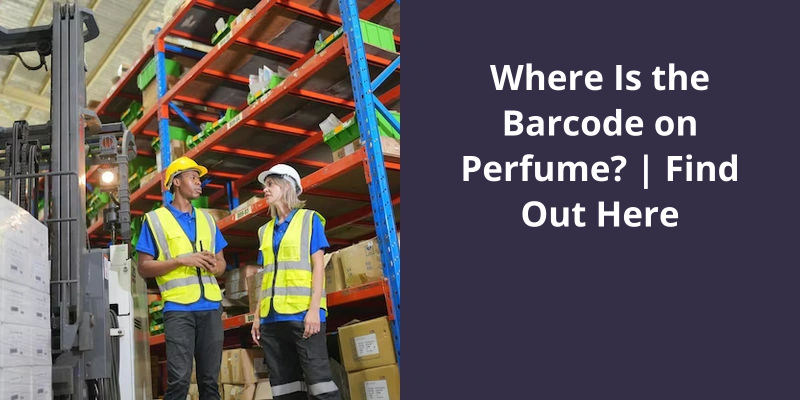The barcode on a perfume bottle is typically located on the box or packaging rather than the bottle itself. This is often the case to avoid detracting from the perfume bottle’s design. The barcode is generally placed on the bottom of the box or sometimes at the side, and represents a unique identifier that provides information related to the product. This includes details such as the country of origin, manufacturer, and product details. Therefore, if you are looking for the barcode, it’s best to check the packaging rather than the perfume bottle.

How Do I Find the Barcode of a Perfume?
When it comes to finding the barcode of a perfume, there are a few important considerations to keep in mind. First and foremost, it’s crucial to exercise caution and pay close attention to the fine print details. This specific placement ensures that the barcode is easily scannable and accessible for retailers and consumers alike.
The same perfume may be manufactured in different locations, resulting in varying barcodes for each production. This distinction is significant as it provides insights into the perfumes origin and production chain. By deciphering the barcode, one can gain a deeper understanding of the perfumes journey from creation to distribution.
Carefully examine the bottom of the box, where the barcode is commonly located for easy scanning purposes. Take the time to compare the barcode with other perfumes of the same brand or scent, as this can help identify any discrepancies or irregularities that may indicate counterfeit products.
Many websites and databases specialize in cataloging and providing details on various products, including perfumes. These platforms often include images and descriptions that can assist in identifying the barcode associated with a particular perfume.
Online sources and fragrance experts can also offer assistance in identifying and validating the barcode associated with a specific perfume.
How to Differentiate Between Genuine and Counterfeit Perfumes Based on the Barcode.
- Check the barcode on the perfume packaging.
- Look for any inconsistencies in the barcode pattern.
- Verify if the numbers below the barcode match the product details.
- Compare the barcode with a trusted database or manufacturer’s website.
- Inspect the barcode for low print quality or smudged ink.
- Pay attention to any spelling errors or unusual characters in the barcode.
- Scrutinize the barcode positioning and alignment on the packaging.
- Check if the barcode is easily scratched or can be peeled off.
- Consider purchasing from authorized retailers or reputable sources.
- Consult fragrance experts or perfume enthusiasts for guidance.
Now that we’ve discussed the positioning of the barcode and the absence of excess glue or tape, let’s delve into other important indicators of authenticity. One of the key elements to look for in a genuine perfume is the presence of essential information, such as the batch, control, and serial numbers on the packaging. These numbers provide valuable insight into the perfume’s origin and ensure it’s legitimacy.
How Can I Tell if My Barcode Perfume Is Real?
When it comes to determining the authenticity of a perfume, one of the key factors to consider is the placement of the barcode. This is an important detail to keep in mind, as counterfeit products often overlook such intricacies.
Additionally, it’s crucial to inspect the packaging for signs of tampering or poor craftsmanship. One way to do this is by examining the presence of excess glue or tape. Authentic perfumes shouldn’t have any messy glue residue or extra tape inside or outside the container. These imperfections are often indicative of counterfeit products, as reputable brands take great care in ensuring the quality of their packaging.
All genuine perfumes should have a batch number, control number, and serial number. These numbers are crucial in confirming the authenticity of the product and can be verified through various methods. It’s recommended to research the specific brand and it’s verification process to ensure accuracy.
However, it’s important to remember that counterfeiters are becoming increasingly sophisticated, so it’s always advisable to purchase perfumes from reputable sources or authorized retailers to minimize the risk of purchasing fake products.
Source: How to Determine Whether a Perfume Is Authentic!
What’s the purpose of the code engraved on the bottom of perfume bottles? This seemingly innocuous marking, known as a batch code, holds valuable information about the production process. It indicates the specific batch in which the perfume was manufactured, enabling consumers and professionals alike to trace it’s origins and expiry date. Delve deeper into the secret world of batch codes and uncover the valuable knowledge they can provide.
What Is the Code on the Bottom of Perfume?
The code on the bottom of a perfume bottle is commonly known as the batch code. This code plays a crucial role in identifying the specific production batch in which a particular perfume was made. It serves as a form of reference for manufacturers, distributors, and consumers alike. While the format and location of the batch code can vary depending on the brand and product, it can usually be found on the bottom of the bottle or on the packaging.
For instance, it may reveal the year, month, or day the batch was produced, or even the factory or line where it was manufactured. This information can be particularly useful for tracking issues or verifying the authenticity of a product.
Manufacturers often use batch codes to monitor quality control, ensure consistency in fragrance formulations, and trace potential issues. By referencing the unique batch code, manufacturers can identify and investigation any reported defects or complaints, and take necessary corrective actions.
It’s worth noting that some brands may have an online database or customer service system that allows users to decode their batch codes. This can be extremely helpful for consumers who want to know more about their perfumes production details or confirm it’s authenticity. However, it’s important to remember that not all brands openly provide this information, as some may consider it proprietary or confidential.
It serves as a reference point for manufacturers, distributors, and consumers, allowing them to track production batches, monitor quality control, and ensure authenticity. By understanding the batch code, perfume enthusiasts can gain a deeper appreciation for the craftsmanship and production processes behind their favorite scents.
How to Decode Perfume Batch Codes: This Topic Could Provide a Step-by-Step Guide on How Consumers Can Interpret the Batch Codes on Their Perfume Bottles.
- Start by locating the batch code, typically found on the bottom of the perfume bottle or on the packaging.
- Identify the format of the batch code, which can vary between perfume brands.
- Research the perfume brand’s batch code system online or contact the brand directly for decoding information.
- Once you’ve the decoding information, start analyzing the batch code.
- Break down the code into different components, such as production date, location, or manufacturing batch.
- Refer to the brand’s decoding system to understand what each component represents.
- Interpret the information accordingly. For example, the production date may be indicated by a combination of numbers or letters.
- Keep in mind that batch codes may differ depending on the region or country of manufacture.
- Use online resources or forums dedicated to perfume batch codes for additional help and insights.
- Note that not all perfume brands have publicly available batch code decoding systems.
The presence of batch codes on bottles of perfume serves as an important indicator of their manufacturing details and authenticity. These codes are commonly located either on the glass or the label, with certain luxury brands even engraving them into the glass itself. While old labels naturally turn brown with time, exposure to water and perfume can lead to unsightly stains on these labels over the years.
Do Bottles of Perfume Have Codes?
When it comes to identifying the authenticity and origin of a bottle of perfume, one important factor to consider is the presence of batch codes. These codes serve as a unique identifier for each specific batch of perfume produced by a manufacturer. They can be found either stamped on the glass of the bottle or on the label itself.
Some high-end perfume brands, such as Chanel, Dior, and Thierry Mugler, go the extra mile and have their batch codes engraved into the glass. This not only adds a touch of elegance to the bottle but also ensures that the code remains intact and visible even after years of use.
Labels, on the other hand, can be a bit trickier to assess. Over time, old labels naturally turn brown due to aging processes. However, water and perfume spills can also cause stains on the labels, further deteriorating their appearance. These stains can sometimes make it difficult to read the batch code, compromising it’s legibility.
For this information, it’s advisable to refer to the brands official website or consult a knowledgeable salesperson.
They can be found either stamped on the glass or engraved into it, while labels may also bear the code but can be susceptible to staining and deterioration.
Conclusion
As consumers, it’s essential to be vigilant and ensure that we’re purchasing genuine and quality products. By understanding the correct placement of barcodes, we can make informed decisions and safeguard ourselves against counterfeit perfumes.





